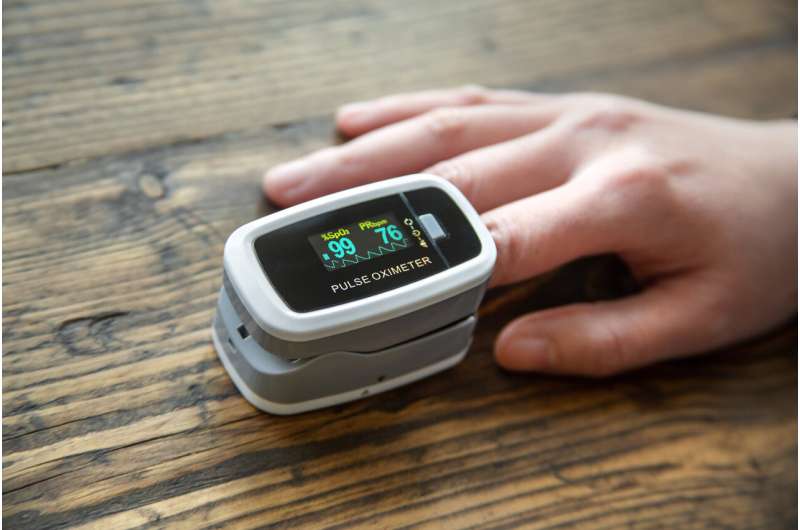Self-monitoring blood oxygen at home can help COVID patients spot early warning signs, study finds

Measuring blood oxygen levels at home is a safe way for people with COVID-19 to spot signs that their health could be deteriorating, and they may need emergency and hospital care, new research led by Imperial College London has found.
Pulse oximeters are widely available, low-cost devices that shine light through a person's finger to assess their blood oxygen saturation. Evidence has shown that a fall in blood oxygen levels is a critical indicator that a COVID-19 patient's health is deteriorating and they may need closer monitoring and urgent treatment.
Led by Imperial's Institute of Global Health Innovation, the study carried out the first extensive evidence review of pulse oximetry and its potential in home monitoring for people with COVID-19.
The research, published in Lancet Digital Health, examined 13 studies involving almost 3,000 participants across five countries, most of which were carried out during the first pandemic wave.
The scientists found that with medical guidance, home pulse oximetry can act as a safety net, reducing unnecessary emergency and hospital admissions for patients who can safely stay at home, while spotting early signs of deterioration and escalating care in those who need it. This would help to save stretched resources, and reduce further potential spread of the virus from contact in health settings.
However, the researchers note a lack of research on darker skinned patients, for whom oximetry may be less accurate than in white people.
Based on their findings, the researchers put forward a set of key recommendations that can help standardise the use of oximetry in home COVID-19 monitoring.
Importantly, the study recommends the use of a defined cutoff point in blood oxygen levels (92%), which will enable healthcare professionals to determine when a patient needs to go to hospital for treatment, or whether they can rule out the need for further care at the time.
Dr. Ahmed Alboksmaty, Research Associate from the Institute of Global Health Innovation, said: "Throughout the pandemic, concern among the public has shifted from 'Have I got COVID?' to 'If I got COVID, do I need to go to hospital?'. Our study shows that people with COVID-19 can safely keep an eye on their blood oxygen levels at home using pulse oximetry. If their oxygen levels drop below a certain point, then this indicates that they need to seek professional medical care.
"Pulse oximetry is easy to self-use, affordable in cost, widely available, and as we have shown, a useful way to identify health deterioration in COVID-19 patients."
Some smartphones and mobile apps also have the capability to measure blood oxygen levels, which the researchers identify as a potentially widely accessible monitoring tool. However, while some studies have reported similar accuracy to traditional pulse oximeters, the researchers concluded that there isn't enough evidence yet to recommend their use for clinical monitoring.
The study also identified further gaps in the current evidence, notably insufficient data to determine whether pulse oximetry can improve the health outlook for patients.
Dr. Ana Luisa Neves, Advanced Research Fellow from the Institute of Global Health Innovation, said: "Our research has demonstrated how the use of pulse oximetry in remote patient monitoring could help ease the strains on health systems during the COVID-19 pandemic. However, it's vital to ensure that the current lack of research in racially and ethnically diverse populations is addressed. It's therefore critical to provide support to ensure this technology reduces, rather than entrenches, existing health inequalities."
"Effectiveness and safety of pulse oximetry in remote home monitoring of COVID-19 patients: A systematic review" by Ahmed Alboksmaty et al. is published in Lancet Digital Health.
More information: Effectiveness and safety of pulse oximetry in remote home monitoring of COVID-19 patients: a systematic review, Lancet Digital Health, 2022. spiral.imperial.ac.uk/handle/10044/1/93017





















